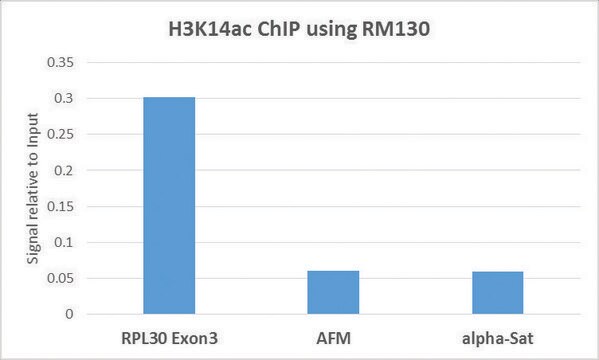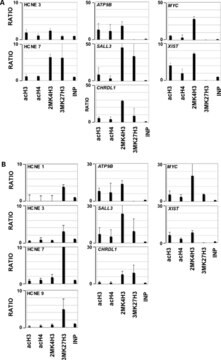07-353
Anti-acetyl-Histone H3 (Lys14) Antibody
serum, Upstate®
Synonym(s):
H3K14Ac, Histone H3 (acetyl K14), H3 histone family, member T, histone 3, H3, histone cluster 3, H3
About This Item
Recommended Products
biological source
rabbit
Quality Level
antibody form
serum
antibody product type
primary antibodies
clone
polyclonal
species reactivity
Saccharomyces cerevisiae, yeast, human
manufacturer/tradename
Upstate®
technique(s)
ChIP: suitable (ChIP-seq)
dot blot: suitable
multiplexing: suitable
western blot: suitable
isotype
IgG
NCBI accession no.
UniProt accession no.
shipped in
dry ice
target post-translational modification
acetylation (Lys14)
Gene Information
human ... H3C1(8350)
General description
Specificity
Immunogen
Application
An independent laboratory has shown this antibody preferentially immunoprecipitates chromatin from wild type yeast and not from yeast strains containing a Lysine substitution to Alanine at residue 14.
Beadlyte Histone-Peptide Specificity Assay:
1:1000-1:5000 dilutions of a previous lot were incubated with histone H3 peptides containing various modifications conjugated to Luminex microspheres. No cross-reactivity with peptides containing acetyl-lysine 9 or acetyl-lysine 27 was detected.
Epigenetics & Nuclear Function
Histones
Quality
Western Blot Analysis:
A 1:1000-1:5000 dilution of this lot detected acetyl-Histone H3 (Lys14) in acid extracts from sodium butyrate treated HeLa cells (Catalog # 17-305).
Target description
Linkage
Physical form
Storage and Stability
For maximum recovery of product, centrifuge the vial prior to removing the cap.
Analysis Note
C6 cell lysate, NIH 3T3 cell lysate, human breast carcinoma and human lung carcinoma.
Other Notes
Legal Information
Disclaimer
Not finding the right product?
Try our Product Selector Tool.
Storage Class Code
12 - Non Combustible Liquids
WGK
WGK 1
Flash Point(F)
Not applicable
Flash Point(C)
Not applicable
Certificates of Analysis (COA)
Search for Certificates of Analysis (COA) by entering the products Lot/Batch Number. Lot and Batch Numbers can be found on a product’s label following the words ‘Lot’ or ‘Batch’.
Already Own This Product?
Find documentation for the products that you have recently purchased in the Document Library.
Our team of scientists has experience in all areas of research including Life Science, Material Science, Chemical Synthesis, Chromatography, Analytical and many others.
Contact Technical Service





